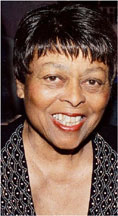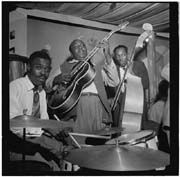The following announcement was released today and I share it with you courtesy of publicist Sue Auclair:
 Joyce Wein, wife and business partner of jazz impresario George Wein, passed away quietly Monday, August 15, at New York Presbyterian Hospital following a battle with cancer. She was 76.
Joyce Wein, wife and business partner of jazz impresario George Wein, passed away quietly Monday, August 15, at New York Presbyterian Hospital following a battle with cancer. She was 76.
Joyce Alexander Wein was born in October 21, 1928, in Boston, Massachusetts, the sixth of seven children of Columbia and Hayes Alexander. Her mother was the youngest of thirteen children, two of whom were born into slavery. Joyce attended Girls Latin School and at the age of 15, entered Simmons College, where she graduated with a major in chemistry in 1948 at the age of 19. After graduation, she started her career as a biochemist at Massachusetts General Hospital in Boston and later in New York at Columbia Medical School.
In 1959, Joyce Alexander married George Wein, founder of the Newport Jazz Festival, and gave up her career in biochemistry. Mr. Wein, an internationally known impresario, leaned heavily on her advice and partnership in the Newport Opera Festival and Newport Jazz Festival, the New Orleans Jazz & Heritage Festival, the Hampton Jazz Festival, and the Grande Parade du Jazz in Nice, France. In 1963, Mrs. Wein joined her husband and Pete and Toshi Seeger in founding the Newport Folk Festival, a major engine of the 1960s folk revival; her tireless work behind the scenes was critical to that event’s success.
A woman of great intelligence and tremendous dignity, she was a renowned art collector, extraordinary hostess, devoted friend and avid supporter of the arts.
 A founder of the New York Coalition of 100 Black Women, the forerunner of coalitions around the nation, Mrs. Wein has been deeply involved with philanthropy and the arts. She was responsible for establishing the Joyce and George Wein Professorship Fund in African-American Studies at Boston University, and recently set up the Alexander Family Endowed Scholarship Fund at Simmons College. She has served on the Board of the Studio Museum in Harlem for ten years, and has partnered with her husband in amassing an important collection of paintings and drawings by African-American artists. (The George and Joyce Wein Collection of African-American Art will be shown at an exhibition at the Boston University Art Gallery from November 18, 2005 through January 22, 2006.) For the past ten years, she and her husband have partnered with Kenneth and Kathryn Chenault, the CEO of American Express and his wife, to host an annual dinner for Geoffrey Canada and the Harlem Children’s Zone, raising over $500,000.
A founder of the New York Coalition of 100 Black Women, the forerunner of coalitions around the nation, Mrs. Wein has been deeply involved with philanthropy and the arts. She was responsible for establishing the Joyce and George Wein Professorship Fund in African-American Studies at Boston University, and recently set up the Alexander Family Endowed Scholarship Fund at Simmons College. She has served on the Board of the Studio Museum in Harlem for ten years, and has partnered with her husband in amassing an important collection of paintings and drawings by African-American artists. (The George and Joyce Wein Collection of African-American Art will be shown at an exhibition at the Boston University Art Gallery from November 18, 2005 through January 22, 2006.) For the past ten years, she and her husband have partnered with Kenneth and Kathryn Chenault, the CEO of American Express and his wife, to host an annual dinner for Geoffrey Canada and the Harlem Children’s Zone, raising over $500,000.
In addition to her husband, Mrs. Wein leaves two sisters, Eugenia Manning of San Francisco, California and Theodora McLaurin of Hingham, Massachusetts and many nieces, nephews, great nieces and nephews.
Funeral Services will be held on Friday, August 19, at 11:30 a.m. at Frank E. Campbell Funeral Chapel, 81st & Madison. Interment following service at Woodlawn Cemetery. Donations can be made in her name to Studio Museum in Harlem, 144 West 125th Street, NY 10027.
Frank E. Campbell The Funeral Chapel
1076 Madison Avenue at 81st Street
New York, NY 10028
Telephone: 212 288 3500
Toll Free: 800 423 5928
http://www.frankecampbell.com/
[Photo of Joyce & George Wein in Newport, 2004 copyright Sue Auclair]
 Guitarist Al Casey, known for his work with Fats Waller, Teddy Wilson, and Billie Holiday, among others, died last week, just a few days short of his 90th birthday. Loren Schoenberg, executive director of The Jazz Museum of Harlem writes:
Guitarist Al Casey, known for his work with Fats Waller, Teddy Wilson, and Billie Holiday, among others, died last week, just a few days short of his 90th birthday. Loren Schoenberg, executive director of The Jazz Museum of Harlem writes:
 Joyce Wein, wife and business partner of jazz impresario George Wein, passed away quietly Monday, August 15, at New York Presbyterian Hospital following a battle with cancer. She was 76.
Joyce Wein, wife and business partner of jazz impresario George Wein, passed away quietly Monday, August 15, at New York Presbyterian Hospital following a battle with cancer. She was 76. A founder of the New York Coalition of 100 Black Women, the forerunner of coalitions around the nation, Mrs. Wein has been deeply involved with philanthropy and the arts. She was responsible for establishing the Joyce and George Wein Professorship Fund in African-American Studies at Boston University, and recently set up the Alexander Family Endowed Scholarship Fund at Simmons College. She has served on the Board of the Studio Museum in Harlem for ten years, and has partnered with her husband in amassing an important collection of paintings and drawings by African-American artists. (The George and Joyce Wein Collection of African-American Art will be shown at an exhibition at the Boston University Art Gallery from November 18, 2005 through January 22, 2006.) For the past ten years, she and her husband have partnered with Kenneth and Kathryn Chenault, the CEO of American Express and his wife, to host an annual dinner for Geoffrey Canada and the Harlem Children’s Zone, raising over $500,000.
A founder of the New York Coalition of 100 Black Women, the forerunner of coalitions around the nation, Mrs. Wein has been deeply involved with philanthropy and the arts. She was responsible for establishing the Joyce and George Wein Professorship Fund in African-American Studies at Boston University, and recently set up the Alexander Family Endowed Scholarship Fund at Simmons College. She has served on the Board of the Studio Museum in Harlem for ten years, and has partnered with her husband in amassing an important collection of paintings and drawings by African-American artists. (The George and Joyce Wein Collection of African-American Art will be shown at an exhibition at the Boston University Art Gallery from November 18, 2005 through January 22, 2006.) For the past ten years, she and her husband have partnered with Kenneth and Kathryn Chenault, the CEO of American Express and his wife, to host an annual dinner for Geoffrey Canada and the Harlem Children’s Zone, raising over $500,000.